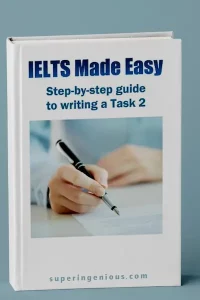IELTS Made Easy Task 2 is a self-study guide for the IELTS test that will teach how to write a really strong easy from the start.
IELTS Made Easy Task 2 Writing
IELTS Made Easy Task 2 book is a self-study guide for the IELTS test. You will learn how to write a really strong easy from the start. This book suitable for all levels. You will see a big change after you finish studying this book.
IELTS Made Easy Writing Task 2
The book is designed to be a self-study guide; however, it can also be used as a guide to teaching IELTS if you are an IELTS instructor.
The book is aimed at all levels. The book contains the basic building blocks of creating a good essay so it is suitable for those who are beginners to IELTS, but there are also tips and strategies that will help you move to the highest band scores (if you have the right grammar abilities).
Although there are essential grammar points in parts of the book (particularly Unit 10 on ‘Coherence and Cohesion’) the book is not designed as a grammar book. The book aims to develop specific skills that help you write an essay in a short space of time and the steps that are involved in this process.
Students often have particular problems with not answering the question properly and finding they do not have enough time in the test, so the book has a particular focus on explaining how to properly analyze and plan an essay and tips and strategies so that you can write essays faster.
The book contains a number of sample essays as illustrations of how to tackle different types of essays.
How to use the book?
It is recommended that you work through the book unit by unit as each unit builds up different skills and they are then built further in the next unit. You can, though, look at specific units if you need particular help in one area.
Contents of The Book
This book contains 10 units and each one of them talks about something. Lets take a fast look on each unit:
- Unit 1 gives an overview of task 2 and some general tips.
- Unit 2 explains why it is so important to spend time analyzing the essay questions and provides you with strategies, tips, and exercises to do this.
- Brainstorming is something candidates always have difficulty with so Unit 3 provides useful tips on how to brainstorm ideas. Unit 4 then shows you how to put these ideas into a plan.
- You don’t want to waste too much time on introductions and conclusions and you need to practice writing introductions quickly so Unit 5 explains how you can do this and gives you a chance to practice writing them.
- The most important parts of your essay are the body paragraphs but they can take a long time to write. Unit 6 explains two types of paragraphs and methods for planning and writing them
- quickly, which you can learn to help you be successful in IELTS. Again, you will have the opportunity to write your own paragraph using the methods you have learned.
- Candidate’s examples in IELTS are often too weak and so Unit 7 gives you top tips on how to develop strong examples. There are guided exercises to help you do this.
- Unit 8 presents you with a simple method for recognizing different essay types and shows you how this is directly related to the way you will organize your essay. Recognizing these different types will save you time in the test. You will have a chance to practice identifying different essay types. Also, model answers are provided for each essay type so you have templates for organizing your essays.
- Candidates find opinion essays particularly difficult so Unit 9 is dedicated to providing you with tips on how to understand and plan for the different opinion type essays.
- Finally, Unit 10 focuses on what you need to do to have a coherent and cohesive essay. The different cohesive devices are explained with grammatical explanations of how to use them and practice exercises to improve how you use them.


